Andrew Cartmel's Blog, page 2
November 29, 2020
Thriller by Bo Vibenius
 I'm currently working on a new podcast about cult cinema with my friend Matt West, who is an expert in such matters.
I'm currently working on a new podcast about cult cinema with my friend Matt West, who is an expert in such matters. And it was Matt who introduced me to this extraordinary movie — I was struck by the T-shirt he was wearing at a Doctor Who convention which we were both attending in Sweden.
Rather aptly, since this is a Swedish film, written and directed by Bo Vibenius, who began his career as a second unit director on Ingmar Bergman pictures.
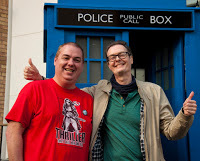
This movie is very definitely not an Ingmar Bergman film, though. Released in the USA by exploitation specialists American International, it was retitled They Call Her One Eye.
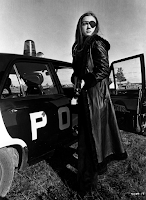
The original Swedish title is Thriller, a loan word from English, subtitled en Grym Film — "A Cruel Movie".
Which it is, recounting the tragedy of Frigga, a young woman who was rendered mute as a child by the trauma of a sexual assault.
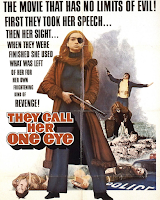 The film begins with this incident and then flashes forward to her as an adult, played by Christina Lindberg. Luckless grownup Frigga is soon abducted, drugged and trafficked...
The film begins with this incident and then flashes forward to her as an adult, played by Christina Lindberg. Luckless grownup Frigga is soon abducted, drugged and trafficked...Hooked on heroin against her will, she is enslaved and forced to work in a brothel.
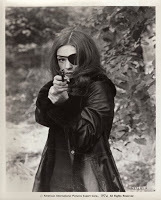 Christina Lindberg is remarkable in this role. Required to remain silent for the entire film, her performance is accomplished through the great expressivity of her face, especially her eyes.
Christina Lindberg is remarkable in this role. Required to remain silent for the entire film, her performance is accomplished through the great expressivity of her face, especially her eyes."Or, rather, her eye," as Matt West remarked... Because when Frigga tries to escape, her captors respond by putting out one of her eyes.
But Frigga, now wearing an eyepatch, is intent on wreaking retribution on them.
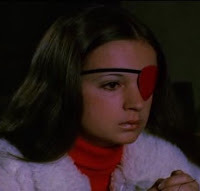
Indeed, the movie was also known in America as Hooker's Revenge — a fairly unforgivable title, suggesting as it does that Frigga's defined by the role she's forced into by others.
The movie is in many ways a mess, with Poverty Row sets and a script that frequently comes unmoored from reality — or even logic.
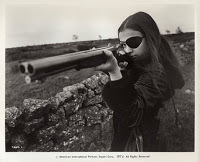 But the photography by Andreas Bellis, is often rapturously beautiful, revelling in the yellows and reds of autumnal Sweden.
But the photography by Andreas Bellis, is often rapturously beautiful, revelling in the yellows and reds of autumnal Sweden.The music is also remarkable, a ferociously avant garde score by Ralph Lundsten.
And while Bo Vibenius is responsible for the film's many defects, he also pulls off some unforgettable sequences — Frigga twisting in torment as a voyeur's camera remorselessly clicks away on motor drive, the hypnotic swirl of a hijacked police car's lights as Frigga drives it to a confrontation.
There's also the scene where Frigga prepares her weapons for her vengeance which anticipates Travis Bickle in Scorsese's Taxi Driver.
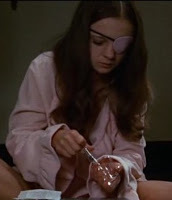 But, ultimately, Thriller is memorable for Lindberg's powerful and affecting performance, and for its mixture of low budget incoherence and wayward brilliance which suggests David Lynch
But, ultimately, Thriller is memorable for Lindberg's powerful and affecting performance, and for its mixture of low budget incoherence and wayward brilliance which suggests David LynchI might also add that my cat has never been so fascinated by a movie — thought it was the Swedish landscapes that caught her attention, not the human activity.
(Image credits: all pics courtesy of Matt West, except for the photo of the two of us in Sweden, which was taken by and is copyright Lee W Lundin.)
November 22, 2020
Dead Bang by Frankenheimer, Beck and Foster
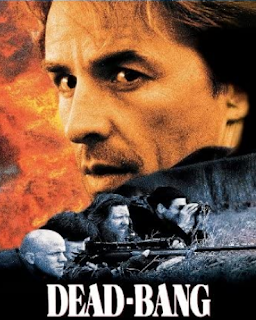 I was recently rivetted by an outstanding BBC radio documentary about the 1995 Oklahoma bombing, the worst domestic terrorist incident in American history.
I was recently rivetted by an outstanding BBC radio documentary about the 1995 Oklahoma bombing, the worst domestic terrorist incident in American history.
It got me thinking about this brilliant movie by John Frankenheimer which I had seen many years earlier.
It's a first rate thriller about a Los Angeles detective whose investigation into the murder of a cop leads him into the murky and murderous world of neo-Nazis and fascists who want to keep America "white and pure."
I tracked down a copy on DVD — it's out of print and not so easy to find — and watched it again.
And I'm delighted to say that Dead Bang is even better than I remembered. I loved it.
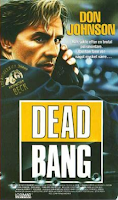
It tells the story of Jerry Beck, played by a compelling Don Johnson, interweaving his chaotic and fractured personal life with his terrifying and thrilling investigation of a lethal conspiracy.
The movie features a taut, efficient and character-rich script by Robert Foster, who has a long pedigree in television stretching back to Run for Your Life in 1967.
The beautiful, fluid camerawork is by Gerry Fisher, a masterful British cinematographer.
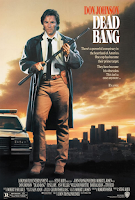 And the magnificent production design is by another Brit, Ken Adam, whose credits include numerous Bond movies and Kubrick's Dr Strangelove and Barry Lyndon. Adam's Nazi stronghold in Dead Bang is particularly notable.
And the magnificent production design is by another Brit, Ken Adam, whose credits include numerous Bond movies and Kubrick's Dr Strangelove and Barry Lyndon. Adam's Nazi stronghold in Dead Bang is particularly notable.
The highly effective music is by Gary Chang and Michael Kamen.
And presiding over all this talent is John Frankenheimer, one of the truly great American film directors (The Manchurian Candidate, The Train, Seconds, The French Connection II, to name a few of his achievements).
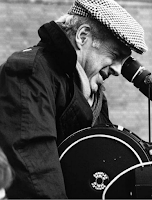 All well and good, but when I began researching this post I experienced some profound surprises.
All well and good, but when I began researching this post I experienced some profound surprises.The first is that Beck is a real person and the movie was based on his actual experiences.
Frankenheimer says, "Jerry Beck, a homicide detective in the Sherrif's Department here in LA... told me the story more or less as it appears on the screen."
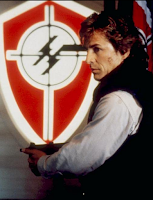 How chilling. What's even more chilling is that, while I thought Dead Bang had been inspired by incidents like the Oklahoma bombing or the sieges at Ruby Ridge (1992) and Waco (1993), it was actually made in 1988 and decisively pre-dates any of them.
How chilling. What's even more chilling is that, while I thought Dead Bang had been inspired by incidents like the Oklahoma bombing or the sieges at Ruby Ridge (1992) and Waco (1993), it was actually made in 1988 and decisively pre-dates any of them.
Dead Bang is an important movie. It was extraordinarily prescient.
It is also gripping, exciting, funny, scary and beautifully made, moving swiftly from Los Angeles to Arizona, Colorado and Oklahoma, where the well turned out wife (Evans Evans) of a Nazi Reverend (Michael Higgins) serves the police hot apple turnovers...
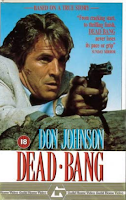 (All three of the locations outside LA were actually shot in Alberta in western Canada, in Calgary, Drumheller and High River, since you ask...)
(All three of the locations outside LA were actually shot in Alberta in western Canada, in Calgary, Drumheller and High River, since you ask...)I can't recommend Dead Bang highly enough, especially given recent events. Do please see if you can find a copy and watch it.
Meanwhile, I'll let John Frankenheimer have the final word:
"I had a good story to tell and it was a well-made movie. Foster, who comes from television, brought the various elements together convincingly. He's a good writer and Jerry Beck is a concerned and colourful character.
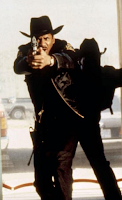 "Ken Adam's production design was remarkable. Gerry Fisher's work was, as usual, excellent, and there were great moments in it. But most importantly the story was topical, urgent and true, in depicting this attempt by the extreme right wing to unite neo-Nazi groups into a dangerous fascist force within the US... This is a real danger both frightening and real. It frightens me."
"Ken Adam's production design was remarkable. Gerry Fisher's work was, as usual, excellent, and there were great moments in it. But most importantly the story was topical, urgent and true, in depicting this attempt by the extreme right wing to unite neo-Nazi groups into a dangerous fascist force within the US... This is a real danger both frightening and real. It frightens me."Amen to that.
(All quotes are from Gerald Pratley's indispensable book on Frankenheimer.)
(Image credits: all from IMDB.)
November 15, 2020
Keoma by Montefiori and Castellari et al
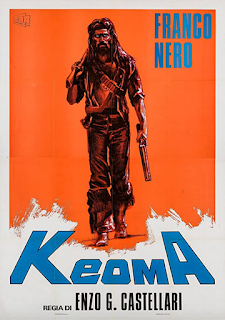 While I am a fan of Spaghetti Westerns I would by no means claim to be an expert.
While I am a fan of Spaghetti Westerns I would by no means claim to be an expert.However, I know enough about the genre to be astonished that I'd never heard of this fantastic movie.
It only came my way because it was recommended to me by my friend Matt West, with whom I am now doing a podcast about cult cinema.
Remind me to tell you some time about how I met Franco Nero, star of Keoma, to get an autograph for Matt. He's a huge fan of Nero and of this movie.
Now I know why. I've never seen a Spaghetti Western shot with such artistry.
And although the slow motion violence in Keoma is influenced by Sam Peckinpah, the film-maker who most comes to mind is Nicolas Roeg.
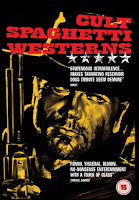 Roeg, at his best, created films of intoxicating beauty and palpable menace that toy with and perturb our perception of time.
Roeg, at his best, created films of intoxicating beauty and palpable menace that toy with and perturb our perception of time.Like Roeg, Keoma's Enzo Castellari interweaves the past and present. But, unlike Roeg and just about every other director, he doesn't do this through intercutting or flashbacks.
Instead he brings the past and present together by filming them in the same shot, often with continuous action and no cuts.
This requires real brilliance in its staging and I'm left in no doubt that there's genius at work here.
 I'm assuming the guiding hand is director Castellari's, though his cinematographer Aiace Parolin must have made a considerable contribution.
I'm assuming the guiding hand is director Castellari's, though his cinematographer Aiace Parolin must have made a considerable contribution.And it doesn't hurt that the film's production designer is the great Carlo Simi, who worked with Sergio Leone on his own Spaghetti Westerns, from A Fistful of Dollars to Once Upon a Time in the West.
Even when the film isn't twining together different time periods, the fluidity and dexterity of the camerawork is amazing, moving smoothly from one beautifully composed dramatic tableau to another.
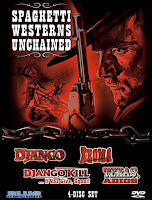 The story in a Spaghetti Western is seldom its strongest feature and that's true here. Keoma has a narrative that is confused and confusing, to say the least.
The story in a Spaghetti Western is seldom its strongest feature and that's true here. Keoma has a narrative that is confused and confusing, to say the least.But Franco Nero is magnificent in the title role, with his pale blue eyes and ironic, introverted performance.
The film also features Woody Strode, who was so excellent in The Professionals and Once Upon a Time in the West, as Keoma's friend and ally George.
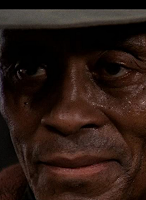 Once a slave, the Civil War has freed George. But he is now the town drunk.
Once a slave, the Civil War has freed George. But he is now the town drunk. Keoma calls him on this, telling him, "But you got your freedom." Only for George to reply, "I found out what it's worth. That's why I drink."
The movie has similarly profoundly cynical (and painfully truthful) things to say about the massacre of the Indians.
Keoma is a Native American himself, although his full beard makes him seem more like some kind of wild psychedelic hippie gunfighter.
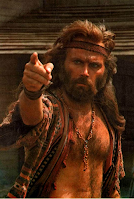 The film has a long list of credited screenwriters, including Luigi Montefiori and Castellari himself.
The film has a long list of credited screenwriters, including Luigi Montefiori and Castellari himself. The music is by the brothers Guido and Maurizio De Angelis, frequent collaborators with Castellari and Franco Nero. Indeed it is Nero who suggested they channel Leonard Cohen, of all people, for the memorable score to this unforgettable Western.
Keoma has a grim and unsatisfying ending, but it is still some kind of masterpiece. If you are interested in Spaghetti Westerns and, like me, had never heard of it, I urge you to seek it out.
(Image credits: All from IMDB.)
November 8, 2020
The Doors by Johnson and Stone
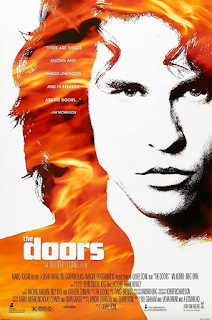 Although jazz is my true love, musically speaking, there's some rock music that was my first love, when I was growing up.
Although jazz is my true love, musically speaking, there's some rock music that was my first love, when I was growing up. And among the bands I regarded so highly then — and still do now — are the Doors.
Oliver Stone is also an admirer. They have "always been my dream band" he says. He first heard their music when he was serving as a soldier in Vietnam.
On his return to the USA, Stone wrote a script entitled Break which featured the songs of the Doors and which he wanted Jim Morrison, their lead singer, to star in.
In fact, after Morrison died in 1971 — dead in his bathtub in Paris, like Marat — a copy of Stone's script was found among his belongings in his apartment.
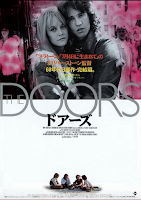 Years later, Morrison's manager gave the script to Oliver Stone when Stone was in the midst of making a movie about the Doors.
Years later, Morrison's manager gave the script to Oliver Stone when Stone was in the midst of making a movie about the Doors.So what we have here is one of my favourite bands being immortalised in a biopic by one of my favourite film makers.
Is it a success? It is a complete success. But whether it's a trip you want to go on is another matter...
The Doors is a powerfully dark story dealing with inherently dark material.
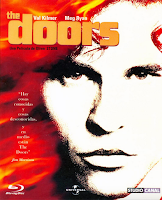 Although Stone would probably prefer the term Dionysian, with death and destruction as just a natural consequence, indeed a celebration, of the intensity of experience sought by the poet-voyager.
Although Stone would probably prefer the term Dionysian, with death and destruction as just a natural consequence, indeed a celebration, of the intensity of experience sought by the poet-voyager.Jim Morrison certain was a poet-voyager. In the film he is superbly played by Val Kilmer. Kilmer looks great as Morrison, with a considerable resemblance to the real man.
And even when he doesn't look so much like Morrison he certainly looks like a rock god on the fast track to self destruction.
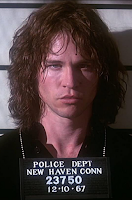
Kilmer can also sing, although he doesn't sound particularly like Morrison — except, oddly, in the scene where he's falling apart on his attempt to record 'Soft Parade'.
Stone says that as a performer Jim Morrison had an "Hitlerian ability... to make people go crazy... And the crowds became bigger and more demanding... And he had to feed them."
The movie Stone has created does full service to that relationship between Morrison and his audience, with superbly staged concerts, each with its own distinctive look and character.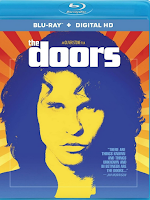 "I like excess. I like grandiosity," says Stone "... huge, huge set pieces." Set pieces like the fantastic concert sequence shot at the Pulgas Water Temple in San Mateo, California.
"I like excess. I like grandiosity," says Stone "... huge, huge set pieces." Set pieces like the fantastic concert sequence shot at the Pulgas Water Temple in San Mateo, California."We had no problem finding extras who could strip and dance naked. Hundreds volunteered."
After Kilmer, the standout member of the cast is Meg Ryan, startlingly cast against type as Pamela Courson, Morrison's long term girlfriend.Courson was a complex and elusive character. "The only thing everyone agreed on was that she was a redhead," says Ryan.
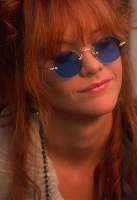
The film is beautifully shot by cinematographer Robert Richardson who does full justice to the hallucinatory nature of the material. "I hadn't tripped in some time," he said, "and when we scouted locations I took some mushrooms..."
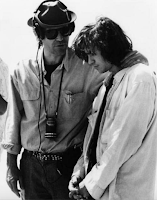 The script is by Stone based on an early version by J. Randal Johnson.
The script is by Stone based on an early version by J. Randal Johnson.
And the music is, of course, by the Doors.
If you're a fan of the Doors then you should definitely see this movie.
If you're not, then I suggest you ignore the movie and instead go and listen to their album LA Woman.
It's their last record, and it's a masterpiece.
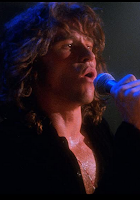
As Stone says of Morrison, "He turned out one of his best albums right at the end...With tremendous decadence comes tremendous creativity."
(The quotes in this post are from the commentary track for The Doors DVD, from a terrific coffee table book on Stone, and from James Riordan's biography of Stone, which was particularly useful.)
(Image credits: IMDB.)
November 1, 2020
Sheena by Stevens, Newman and Semple
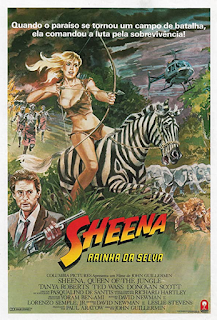 My friend Matt West and I have just launched a podcast where we talk about cult films. (Matt hates the term "cult film" but he doesn't read this blog, so I think we're safe...)
My friend Matt West and I have just launched a podcast where we talk about cult films. (Matt hates the term "cult film" but he doesn't read this blog, so I think we're safe...)The podcast's concept — if we can dignify it with that term — is that Matt chooses the movies and then he and I, his helpless victim, watch them and discuss them.
This method has already brought a slew of odd and intriguing film my way. But this is my absolute favourite so far.
You wouldn't know it from the credits on the movie, but 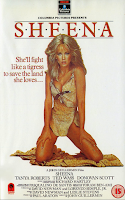 Sheena, or Sheena the Queen of the Jungle, began life as a comic book.
Sheena, or Sheena the Queen of the Jungle, began life as a comic book.
Sheena was created by Will Eisner and Jerry Iger in 1937, first appearing in a story written by William Thomas and drawn by Mort Meskin in 1938.
I'm getting these facts — as I say, conspicuously absent from the movie — from The World Encyclopedia of Comics edited by Maurice Horn.
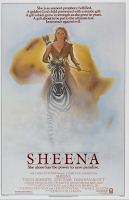
Which goes on to say that it was "the only worthy comic book competition" to Tarzan and describes it as featuring "healthy doses of sex, sadism and items surely aimed at arousing 'prurient interests'."
Those prurient interests are also likely to be aroused by the movie, too, which is a large part of its charm. (That and the animals.)
The film was directed by John Guillermin, who also made The Towering Inferno and is beginning to arouse my interest as an oddball and intriguing figure in the history of the movies.
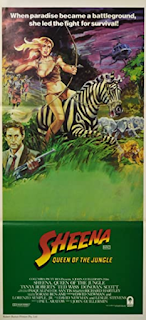 Sheena is in no way a sophisticated masterpiece of cinema. It has all the flaws you might expect — including some dodgy special effects and shaky acting.
Sheena is in no way a sophisticated masterpiece of cinema. It has all the flaws you might expect — including some dodgy special effects and shaky acting. And it is certainly open to criticism over issues of sex, race and animal exploitation.
Nevertheless, it is terrific hoky fun and also a really well crafted piece of entertainment, thanks largely to a surprisingly smart script.
These kind of comic book movies are really easy to screw up, and screw-ups were even more common back in the 1980s when today's template of cheeky and slick Marvel adaptations didn't yet exist.
But the screenplay of Sheena makes a lot of smart decisions. Sheena has a cool origin story, and psychic powers which allow her to summon the aid of animals — neither of which, I believe were in the comics.
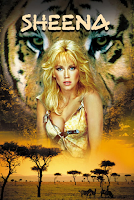
The writers also made the smart decision of fashioning virtually the entire film as a chase and fight.
Sheena (Tanya Roberts) and American journalist Vic Casey (Ted Wass) are on the run from an evil African monarch Prince Otwani (Trevor Thomas) who has just murdered his benign brother and stolen his throne.
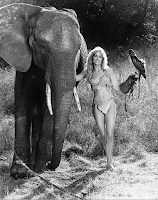 Sheena and Vic have got the goods on him so the Prince is pursuing them with a small army of white mercenaries.
Sheena and Vic have got the goods on him so the Prince is pursuing them with a small army of white mercenaries.
Our heroine and Vic eventually prevail with the assistance of some wonderful African wildlife. (As I mention in the podcast, Sheena features what is no doubt the finest flamingo attack in the history of cinema.)
The animals and the location photography by Pasqualino De Santis are two of the films greatest assets. Richard Hartley also provides a rousing synth based score — there's a notable theme for Sheena riding on her zebra past a lake full of the aforementioned flamingos.
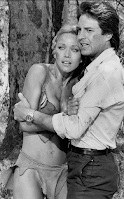 But it is the script which is the standout feature of Sheena. As I say, it's surprisingly difficult to fashion a silly comic book into an effective film.
But it is the script which is the standout feature of Sheena. As I say, it's surprisingly difficult to fashion a silly comic book into an effective film.The writers who succeeded here are a distinguished group. The first draft was by Leslie Stevens who took the story in a science fiction fantasy direction (not surprising from the creator of The Outer Limits).
The next draft was by David Newman, a distinguished writer who co-wrote Bonnie and Clyde and, more to the point, Superman.
There was then an uncredited rewrite by Dean Reisner, a prolific and proficient writer who was involved in Dirty Harry among many other credits.

The final credited writer was the terrific Lorenzo Semple Jr who had a flair for this sort of material — he created the 1960s Batman TV series and worked on King Kong and Flash Gordon.
But since this is a movie called Sheena I need to say something about Tanya Roberts.
A former Charlie's Angel and Bond girl, Roberts does a hell of a job of swinging on vines and riding wild animals (that zebra was a painted horse, by the way, you can't domesticate zebras).
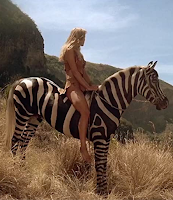 She is commendably effective in a difficult and physically demanding part, including a very amusing nude scene where — innocent child of nature that she is — Sheena doesn't understand Vic Casey's discomfort in her unclothed presence.
She is commendably effective in a difficult and physically demanding part, including a very amusing nude scene where — innocent child of nature that she is — Sheena doesn't understand Vic Casey's discomfort in her unclothed presence.If her performance isn't always entirely convincing well, hell, it isn't easy playing the Queen of the Jungle...
(Image credits: IMDB. I particularly like the strap line "She'll fight like a tigress." There are no tigers in Africa, as Edgar Rice Burroughs found out to his cost after including one in his first Tarzan story...)
October 25, 2020
Midnight Express by Hayes, Hoffer and Stone
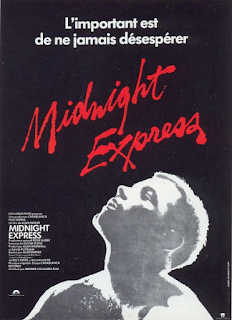 Writing the screenplay for Platoon in 1976 was a major turning point in Oliver Stone's life and career. No one wanted to make such a raw and realistic film about the war in Vietnam... But everyone recognised the brilliance of the writing.
Writing the screenplay for Platoon in 1976 was a major turning point in Oliver Stone's life and career. No one wanted to make such a raw and realistic film about the war in Vietnam... But everyone recognised the brilliance of the writing. And soon Stone found himself hired by Peter Guber at Columbia Pictures to create a screenplay from a book called Midnight Express.
Written by Billy Hayes and William Hoffer, Midnight Express is the true story of how Hayes was busted for trying to smuggle hashish out of Turkey and how he was incarcerated and brutalised in a Turkish prison, before finally escaping.
Oliver Stone was the perfect writer to adapt this tale for the screen.
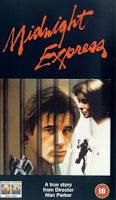
"When I interviewed Billy Hayes I conflated him with myself because I'd been busted and I hated the authorities... I conflated two things: Billy's story, and my anger at being busted in San Diego for two ounces of grass... facing federal smuggling charges of five to twenty years..."
Peter Guber at Columbia also decided that the ideal director for Midnight Express would be the British Alan Parker.
Parker liked the book and signed up to do the movie with his friend and ally David Puttnam as the producer.
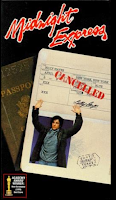
The only problem was this crazy, unknown American called Oliver Stone who'd been hired to write the script. "Guber... sort of forced me on Puttnam and Parker, who were sceptical," Stone recalls.
"I think they figured that... they'd bring me over to London and run through a quick draft, and then get rid of me."
Stone is completely correct in this. In his commentary track for the Blu-ray on Midnight Express, Alan Parker confirms that the idea was that out of courtesy to Columbia they would let Stone deliver a screenplay and then Parker would take over and the real writing would begin...
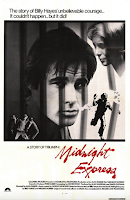 "We would put up with this strange individual and then he would go away and I would write the screenplay," says Parker.
"We would put up with this strange individual and then he would go away and I would write the screenplay," says Parker. However... "When he delivered the first draft it was so good we were kind of in shock, really. Because though we weren't enamoured with Oliver... he wrote a very excellent first draft."
Stone, for his part, says, "I must say that Parker, though he was cold to me the whole time, maintained the integrity of the script. Alan and David Puttnam were put under a great deal of pressure to tone the film down, but they held out. They fought to shoot my screenplay."
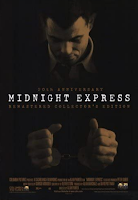
And the result was a powerful, harrowing, beautifully made film which still stands up today, over 40 years later.
Alan Parker did a magnificent job of directing the film and, as indicated, Stone's screenplay is outstanding.
Mention must also be made of the excellent second unit photography in Turkey, directed by Hugh Hudson, and the outstanding cast — chiefly Brad Davis as Billy and John Hurt and Randy Quaid as his friends in prison, Max and Jimmy.
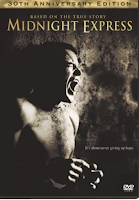
It's very strange that Brad Davis never went on to achieve considerable stature in the movies, unlike Hurt and Quaid.
And unlike Oliver Stone.
Midnight Express was both a commercial and critical hit. And Stone's screenplay was recognised as a major factor in its success.
He won a Golden Globe for the screenplay, although the award ceremony was something of a fiasco: "That night I was stoned out of my head on Quaaludes and coke... I made this long, obfuscating speech attacking the drug laws...I was being hissed and booed off the stage."
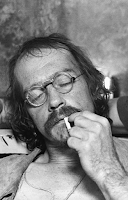 Afterwards David Puttnam angrily confronted Stone, "You'll never get an Academy Award," he snarled.
Afterwards David Puttnam angrily confronted Stone, "You'll never get an Academy Award," he snarled.But he was wrong. In 1979 Oliver Stone won the Oscar for Midnight Express and his career as a film maker was well and truly under way.
(The quotes for this post are from two sources: James Riordan's excellent biography of Oliver Stone. And a superb coffee table book about Stone that is responsible for sending me on this deep dive into his work.)
(Image credits: IMDB.)
October 18, 2020
Heaven and Earth by Hayslip and Stone
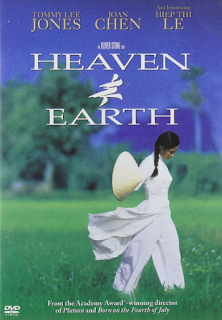 Oliver Stone has an undeserved reputation as a macho film maker, and perhaps even a misogynist or sexist one. "I'm just not that type of person," he says.*
Oliver Stone has an undeserved reputation as a macho film maker, and perhaps even a misogynist or sexist one. "I'm just not that type of person," he says.* A powerful confirmation of this can be found as early as Salvador (1986), his first major film.
In that raw, fact-based drama there's a chilling sequence in which a right wing death squad attacks a bus full of nuns.
The murderous assault is shot from the women's point of view so that we, the audience, see the vile leering faces of these vicious thugs leering and drooling over us.
There is no question where Stone's sympathies lie.
And with Heaven and Earth (1993) he shot an entire movie from a female point of view, so to speak.
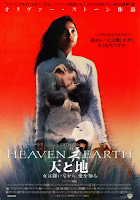
Again it's a true story, based on two autobiographical books by Le Ly Hayslip (played by Hiep Thi Le), a Vietnamese woman who married an American soldier and escaped to the USA.
("Escaped" is very much an apt term, considering Le Ly's harrowing odyssey...)
This is third and final part of Oliver Stone's Vietnam trilogy — begun with Platoon and Born on the Fourth of July.
And in many ways it's his most ambitious. It's obviously deeply felt.
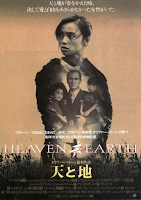 And in the early sections it seems to be shaping up to be Stone's masterpiece.
And in the early sections it seems to be shaping up to be Stone's masterpiece.Le Ly is a happy child in the idyllic rural landscape with black water buffalo wading through glowing green rice paddies. It's a lush paradise that will never be the same after the war arrives.
Le Ly's straw hat is blown away by the wash of a helicopter in a sequence reminiscent of Platoon, where the copters blow the coverings off corpses waiting to be transported back to America...
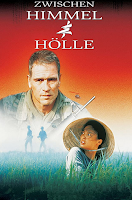 arrested and tortured by the American-sponsored government because she's suspected of collaborating with the Vietcong.
arrested and tortured by the American-sponsored government because she's suspected of collaborating with the Vietcong.And then she's abducted and assaulted by the Vietcong because they suspect her of cooperating with the government.
After further misfortunes, Le Ly ends up pregnant out of wedlock, picking through the trash of a US army base and finding the bodies of murdered prostitutes, discarded like garbage.
Then she is pressured into prostitution herself, as her baby boy screams at being abandoned.
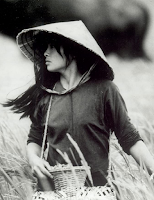
The film is fearsomely potent up to the point of Le Ly's arrival in America married to Steve Butler (Tommy Lee Jones).
And initially the culture clash of Le Ly in her new home is forceful and funny — she watches a giant woman opening a giant refrigerator, and marvels... But soon thereafter, I feel, the movie goes seriously off the rails.
In sharp contrast to Platoon or Born on the Fourth of July, it's hard to know what we're supposed to care about — or even be interested in.
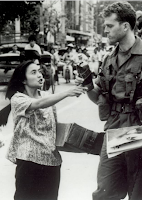
Sequences that should be deeply moving — a shaman telling Le Ly her husband's spirit is in the house, her brother describing the terrible aftermath of the war, Le Ly's return to the shrine in the village — instead come across as dangerously close to Pythonesque.
In any case, the film was a financial failure. Or as Stone puts it: "the reception... brutal, and it didn't do anything at the box office... but I loved that movie."
(*The quotes by Stone are from this book, which I highly recommend. Image credits: All from IMDB.)
October 11, 2020
Talk Radio by Bogossian & Stone
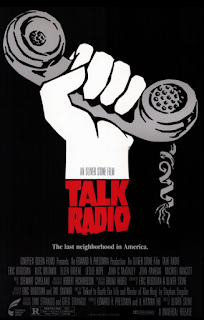 After making Wall Street and while he was waiting for Tom Cruise to become available for Born on the Fourth of July, Oliver Stone squeezed in a quick little low budget picture.
After making Wall Street and while he was waiting for Tom Cruise to become available for Born on the Fourth of July, Oliver Stone squeezed in a quick little low budget picture.
It was shot in Dallas, where much of the filming for Born on the Fourth of July would take place. This would enable Stone to get to know the place and the local film crews and facilities.
It would also enable him and his cinematographer Robert Richardson to get used to shooting in confined spaces, something they were planning to do a lot in Born, where Tom Cruise was confined to a wheelchair.
Talk Radio was the story of a disc jockey, so a large portion of the movie is spent up close with him bent over his microphone in the radio station.
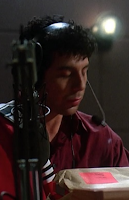 This project also, to be candid, allowed Oliver Stone to satisfy his hunger for film making. Stone liked working fast and cheap. It was what he had done with his first two pictures, Salvador and Platoon.
This project also, to be candid, allowed Oliver Stone to satisfy his hunger for film making. Stone liked working fast and cheap. It was what he had done with his first two pictures, Salvador and Platoon.Wall Street had been an entirely different beast. A big studio movie. Born on the Fourth of July would be another one.
But in the nine months between the one ending and the other beginning, Stone returned to his guerrilla film making roots.
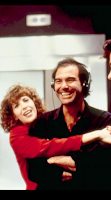 Talk Radio was based on a stage play written by Eric Bogossian in which he'd also played the lead role. Bogossian was again the lead in the movie. The play concerned a controversial DJ, what we'd now call a shock jock, but which then was something relatively new on the airwaves, and it took place during one program on one night.
Talk Radio was based on a stage play written by Eric Bogossian in which he'd also played the lead role. Bogossian was again the lead in the movie. The play concerned a controversial DJ, what we'd now call a shock jock, but which then was something relatively new on the airwaves, and it took place during one program on one night.Stone expanded the story in several ways. Most importantly he combined it with the true story of disc jockey Alan Berg in Denver who'd been murdered by white supremacists.
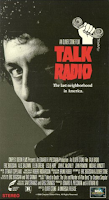 Although the film is firmly centred on the DJ, here called Barry Champlain, it also crucially deals with his callers, mostly disembodied voices — although one of them, Kent, a heavy metal prankster unforgettably played by Michael Wincott, turns up at the radio station.
Although the film is firmly centred on the DJ, here called Barry Champlain, it also crucially deals with his callers, mostly disembodied voices — although one of them, Kent, a heavy metal prankster unforgettably played by Michael Wincott, turns up at the radio station. "Those callers are the costars of the movie, and they're invisible," says Oliver Stone.* And they make an indelible impression in the course of the film, though not quite as indelible as Barry's assassination at the end, in a rooftop carpark.
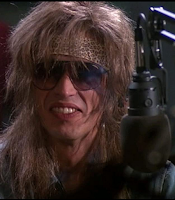
The camera floats above his body, like his spirit rising upwards, then pans across the night time skyscrapers of Dallas in a masterful shot, overlaid with a collage of voices, as conflicted about Barry in his death as they were in his life. It's one of Stone's finest moments.
 (*My deep dive into the films of Oliver Stone was prompted by a most compelling book, which was the source of this quote.)
(*My deep dive into the films of Oliver Stone was prompted by a most compelling book, which was the source of this quote.)
(Image credits: IMDB.)
October 4, 2020
Wall Street by Weiser & Stone
The first surprise for me about this movie was that it was Stone's very next film after Platoon. It's such radically different source material that I thought it must have been made years later.
But to Stone, the son of a stockbroker, this story was close to his heart. "It was really an exploration of my father's world, which I found fascinating."*
It's a world in which the fabulously named Gordon Gekko rules. Played by Michael Douglas, Gekko is a ruthless, shady and highly successful entrepreneur.
The movie is now a classic, remembered for the Gekko quote, "Greed is good." (Although like "Play it again Sam" in Casablanca, that exact phrase never actually occurs in the film.)
Gekko becomes a kind of dark-side mentor to the ambitious  young Bud Fox.
young Bud Fox.
Fox is played by Charlie Sheen and, as with Tom Cruise in Born on the Fourth of July, Oliver Stone gets a surprisingly effective performance out of his young leading man.
Having been at the centre of Stone's first two films, it looked as if Charlie Sheen might turn into a long term collaborator with the director, but Wall Street was effectively the end of their partnership.
Stone now speaks about him with some disillusion: "he wasn't looking to change the  world... he really loved money... and being in the Wall Street world certainly sharpened his appetites."
world... he really loved money... and being in the Wall Street world certainly sharpened his appetites."
He also compares Charlie unfavourably with his father, the distinguished actor Martin Sheen. "I can't say Charlie... would make his dad proud... definitely more interested in money."
But maybe all this made Charlie Sheen perfect for the part of a young man who is seduced and corrupted by money and who l acks the integrity of his father and betrays his values.
acks the integrity of his father and betrays his values.
Ironically, Bud Fox's father is played in the movie by Martin Sheen himself.
Co-written by Oliver Stone and Stanley Weiser, Wall Street stands up well. Some of the fashions have dated, of course...
And the allegedly cutting edge interior design of Bud Fox's luxury apartment, chosen by his luxury girlfriend Darien Taylor (Daryl Hannah), looks utterly ludicrous.
 But then I remember thinking that it looked utterly ludicrous when I first saw the film in the cinema back in 1987.
But then I remember thinking that it looked utterly ludicrous when I first saw the film in the cinema back in 1987.
Stone has described the movie as Pilgrim's Progress on Wall Street and it's a neat, tight story. Bud Fox desperately wants to win Gekko's approval and a place on his team.
So he gives Gekko inside information about the regional airline where Bud's dad is a blue collar worker.
The ploy works only too well, with Gekko buying the airline with a plan to gut it, sell off its assets and drain its pension fund (s ound familiar?)...
ound familiar?)...
Bud Fox finds that he has effectively destroyed his own father, and he belatedly realises Gekko is the enemy and takes action against him.
In a way, it's a retelling of the story of Platoon, with a young man caught between two father figures, both appealing, one good and one evil.
At the time of its release Wall Street was badly received critically and only received one Oscar nomination — a winning one for Michael Douglas ("in the part, in the movie, he surprised people," says Stone).
of its release Wall Street was badly received critically and only received one Oscar nomination — a winning one for Michael Douglas ("in the part, in the movie, he surprised people," says Stone).
But as I say, the film stands up well and I liked it when I watched it again.
And I'd forgotten that Bud Fox doesn't get off scot-free, either.
He is crying like a baby as he is led out in handcuffs at the e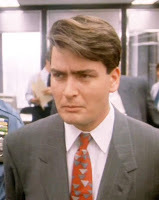 nd.
nd.Very gratifying.
The wall in question was that of the stockade where they kept the slaves.
(*All the quotes by Stone are from the superb book which set me off on this retrospective.)
(Image credits: Thank you, IMDB.)
September 27, 2020
Any Given Sunday by Pyne & Logan & Stone
 I am the last guy to take any interest in sport, in any of its myriad stultifying forms. Yet I was very pleased when my informal Oliver Stone retrospective brought me to this movie.
I am the last guy to take any interest in sport, in any of its myriad stultifying forms. Yet I was very pleased when my informal Oliver Stone retrospective brought me to this movie.
I'd always loved the title... It's so economical and evocative.
It is actually an improvement of the title of a script called On Any Sunday by John Logan ("a really excellent writer," says Stone). It is telling that Logan wrote the movie Gladiator.
On Any Given Sunday definitely presents a gladiatorial view of the sport. (Stone says, "I played football in elementary school... I think I liked the violence of the game.")
But that John Logan script was just the starting point of this movie. It was then combined with a factual book by Robert Huizenga, who had been a team physician for the Los Angeles Raiders, and who exposed a lot of seamy practices in big league football.
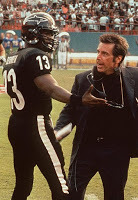
In the movie there are two physicians, the senior being the wonderfully named Harvey Mandrake (James Woods), who is willing to pass men as fit to play even if they're likely to drop dead on the field.
Meanwhile, Matthew Modine plays Ollie Powers, the younger and more idealistic doctor who corresponds to Huizenga and who fights for reform.
But these two medics are just a small part of a big and complex movie, which is one reason that Huizenga didn't end up with his name on the writing credits — which go to Logan, Stone and Daniel Pyne.
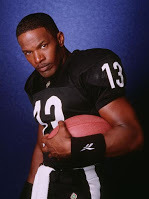
Essentially the film is about Al Pacino as the ageing coach Tony D'Amato and Jamie Foxx as Willie Beamen, an inexperienced young quarterback who is given his big chance.
"Each one of those concerts represents another stage of Jim's journey, as do these games for Pacino and Jamie Foxx."
 But, as discussed on this excellent interview on the BBC World Service, despite being a very male oriented movie, On Any Given Sunday features some of Stone's strongest women — like Lauren Holly as Cindy Rooney.
But, as discussed on this excellent interview on the BBC World Service, despite being a very male oriented movie, On Any Given Sunday features some of Stone's strongest women — like Lauren Holly as Cindy Rooney.
She's married to Jack 'Cap' Rooney (Dennis Quaid), the senior quarterback whose serious injuries open the door for Willie Beamen.
When Cap tells Cindy that he doesn't think he can stand the pain and pressure of playing any more... she punches him in the face.
 And then there is Christina Pagniacci, the owner of the team, played by Cameron Diaz.
And then there is Christina Pagniacci, the owner of the team, played by Cameron Diaz.
Unlike the female druglord in Savages, there was no factual historical precedent for such a person. "There was nobody like that — no female owners," says Stone.
And Diaz is a revelation. She was cast in the movie at a time when she was still principally known for her comic roles. But she is perfect.
And there's a classic moment when she comes into the locker room full of players after a game, looking chic and poised and collected in an elegant black Chanel dress while these gargantuan naked gladiators tower over her.
"She was cool as a cucumber," Stone says.
It's an unforgettable image from a film that's full of memorable visuals — a practise machine throws a football soaring into a blue sky, a rainswept field full of muddy, dripping players heaves like a primordial swamp.
 Like I say, I couldn't care less about sport. But I was utterly caught up in the fate of this fictional team and its vividly evoked characters.
Like I say, I couldn't care less about sport. But I was utterly caught up in the fate of this fictional team and its vividly evoked characters.
(As with my other recent posts, the quotes by Oliver Stone are taken from this excellent book on him.)
(Image credits: IMDB.)




